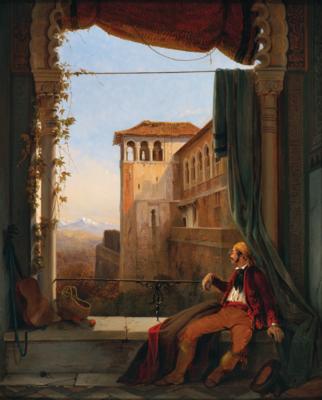Romantic Painter c. 1850
Granada, Impressions of the Alhambra, oil on canvas, 47 x 38 cm, framed
Provenance:
Private Collection, Germany.
Compare:
Georg Vivian, Scenery of Portugal and Spain, London/Paris/Berlin, 1839, No. 32.
The Alhambra above Granada is one of the most important examples of Islamic architecture and one of the major surviving castles built by the Arabs in Spain during the Middle Ages. In 1832, a bestseller by the Romantic author Washington Irving revived interest in this architectural beauty, which had been left to decay for centuries.
An attribution of the presnet lot to Louis Haghe (1806-1885) has been suggested, one of the leading lithographers of his time. By 1852 he had, however, given up lithography and from then on mainly executed watercolours but also some oil paintings. The present painting was perhaps most likely created in the 1850s. Louis Haghe had become particularly famous through his collaboration with David Roberts (1796-1864). As an accomplished artist himself, he not only managed the technical feat of transferring Roberts' drawings and watercolours to stone for print reproduction, but also transformed them into finely crafted works of intrinsic artistic value, which later enabled him to paint creatively himself. Haghe and Roberts cultivated a close friendship. David Roberts can be ruled out as the painter of this work because of his differing style and muted colouring. However, he may have provided his friend Louis Haghe with templates for the architectural elements of this painting from his trip to Spain, such as the watercolour "The Alhambra, 1834" (Sotheby’s, London, auction 29.11.2001, lot 319). Haghe's painting is characterised by brighter colouring, carefully positioned figures and a narrative, sometimes minutely detailed, depiction. Stage-like vistas framed by columns and incorporating climbing foliage (vines or ivy), as in this painting, can also be found in his other works.
Louis Haghe evidently used his own drawing based on a model by George Vivian (1798-1873) for the relaxed Spaniard in the painting, which he had transferred onto stone with a different background for lithograph no. 32 "Scenery of Portugal and Spain" (1839) (in the print, of course, reversed). George Vivian himself can be ruled out as the creator of the painting due to his completely different style of oil painting. The infrared image of the picture makes pentimenti and underdrawings visible, revealing the composition’s development during the painting process. The depiction of the man in Spanish costume was further developed in comparison to the lithograph, the position of his body and arm changed and his cigarillo replaced by a cigarette. Paper cigarettes were not invented until around 1850 by tobacco workers in Spain and France.
Esperta: Mag. Dimitra Reimüller
 Mag. Dimitra Reimüller
Mag. Dimitra Reimüller
+43-1-515 60-355
19c.paintings@dorotheum.at
25.04.2024 - 18:00
- Stima:
-
EUR 15.000,- a EUR 20.000,-
Osserva lotto Non osservare più
Romantic Painter c. 1850
Granada, Impressions of the Alhambra, oil on canvas, 47 x 38 cm, framed
Provenance:
Private Collection, Germany.
Compare:
Georg Vivian, Scenery of Portugal and Spain, London/Paris/Berlin, 1839, No. 32.
The Alhambra above Granada is one of the most important examples of Islamic architecture and one of the major surviving castles built by the Arabs in Spain during the Middle Ages. In 1832, a bestseller by the Romantic author Washington Irving revived interest in this architectural beauty, which had been left to decay for centuries.
An attribution of the presnet lot to Louis Haghe (1806-1885) has been suggested, one of the leading lithographers of his time. By 1852 he had, however, given up lithography and from then on mainly executed watercolours but also some oil paintings. The present painting was perhaps most likely created in the 1850s. Louis Haghe had become particularly famous through his collaboration with David Roberts (1796-1864). As an accomplished artist himself, he not only managed the technical feat of transferring Roberts' drawings and watercolours to stone for print reproduction, but also transformed them into finely crafted works of intrinsic artistic value, which later enabled him to paint creatively himself. Haghe and Roberts cultivated a close friendship. David Roberts can be ruled out as the painter of this work because of his differing style and muted colouring. However, he may have provided his friend Louis Haghe with templates for the architectural elements of this painting from his trip to Spain, such as the watercolour "The Alhambra, 1834" (Sotheby’s, London, auction 29.11.2001, lot 319). Haghe's painting is characterised by brighter colouring, carefully positioned figures and a narrative, sometimes minutely detailed, depiction. Stage-like vistas framed by columns and incorporating climbing foliage (vines or ivy), as in this painting, can also be found in his other works.
Louis Haghe evidently used his own drawing based on a model by George Vivian (1798-1873) for the relaxed Spaniard in the painting, which he had transferred onto stone with a different background for lithograph no. 32 "Scenery of Portugal and Spain" (1839) (in the print, of course, reversed). George Vivian himself can be ruled out as the creator of the painting due to his completely different style of oil painting. The infrared image of the picture makes pentimenti and underdrawings visible, revealing the composition’s development during the painting process. The depiction of the man in Spanish costume was further developed in comparison to the lithograph, the position of his body and arm changed and his cigarillo replaced by a cigarette. Paper cigarettes were not invented until around 1850 by tobacco workers in Spain and France.
Esperta: Mag. Dimitra Reimüller
 Mag. Dimitra Reimüller
Mag. Dimitra Reimüller
+43-1-515 60-355
19c.paintings@dorotheum.at
|
Hotline dell'acquirente
lun-ven: 10.00 - 17.00
kundendienst@dorotheum.at +43 1 515 60 200 |
| Asta: | Dipinti dell’Ottocento |
| Tipo d'asta: | Asta in sala con Live Bidding |
| Data: | 25.04.2024 - 18:00 |
| Luogo dell'asta: | Wien | Palais Dorotheum |
| Esposizione: | 13.04. - 25.04.2024 |

